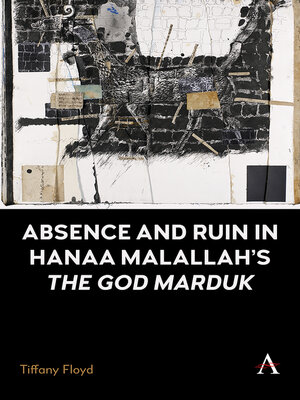Absence and Ruin in Hanaa Malallah's the God Marduk
ebook ∣ Anthem Modern and Contemporary Art of the Arab World, Iran and Turkey
By Tiffany Floyd

Sign up to save your library
With an OverDrive account, you can save your favorite libraries for at-a-glance information about availability. Find out more about OverDrive accounts.
Find this title in Libby, the library reading app by OverDrive.



Search for a digital library with this title
Title found at these libraries:
| Loading... |
This book is an object biography that provides an analysis of a single artwork by contemporary Iraqi artist Hanaa Malallah to consider how modern Iraqi art was fundamentally altered as a result of the sanctions and wars of the late twentieth century and early twenty-first leading to a transition from the modern into the contemporary – a shift that has yet to be satisfactorily theorized. This study contextualizes Malallah's art book The God Marduk(2008) within the artistic trajectories of the artist's education and career in Iraq during the 1980s and 1990s. It will, furthermore, investigate Malallah's use of the ancient past as a conduit for aesthetic and emotive expression offering an in-depth analysis through the methodology of phenomenology. The book concludes with a reflection on Iraqi art in the post-2003 period.
|
This book offers an in-depth analysis and contextualization of Hanaa Malallah's art book The God Marduk, published in 2008. Currently housed in storage at the British Museum, Malallah's art book is not only a poignant manifestation of the artist's signature 'Ruins Technique' but also a document that responds to a critical contextual moment wherein Iraqi artists looked back upon and continued to grapple with the cultural ruins of their nation. The artbook itself is a complex configuration of materials, narratives and formal arrangements that speak of both meticulous construction and expressive release. Bound on both sides, the book is constructed with a non-linear, multidirectional rhythm holding folios of various sizes, cuts, patterns, texts and images. Extra materials are placed into pockets multiplying the modes of interface while several pages are punctured and torn to allow one page to meld into the next. Opening outwards on either side, the pages form a range of conceivable permutations so that it is possible to open the book differently with each viewing. Malallah's book cannot thus be 'read' by flipping pages in a prescribed sequence, but through the motions of unfurling, unfolding and uncovering. These actions reveal (and conceal) an ever-expanding (and contracting) centralized tableau of the God Marduk's dragon, a composite creature always in flux. As a multifaceted object document, Malallah's art book acts as a prism refracting various strands of her personal artistic journey and that of her peers.
HanaaMalallah belongs to the 'Eighties Generation' of Iraqi artists, those who were educated in Baghdad during the 1980s and remained in the country during the sanctions of the 1990s through the US-led invasion of 2003. During this time, members of the 'Eighties Generation' continued to produce artwork despite the uncertainties of war as not only a cathartic release and mode of expressing trauma but also as a means of understanding new artistic realities necessitated by isolation and insecurity. Along with the relative dearth of scholarly material on Iraqi modern and contemporary art –the notable work of Nada Shabout, Elizabeth Rauh, Sarah Johnson and Saleem al-Bahloly notwithstanding – this 30-year period (between the last two decades of the twentieth century and the first decade of the twenty-first) has yet to be fully theorized as a time of transition whereby the narratives of Iraqi modernity give way to a new sensibility, what might be called Iraqi contemporary art. This book seeks to understand this period of transition through Malallah's work The God Marduk. I argue that this artbook carries within it both the problems of the past and the promises of the future through a process of internalizing an archeological vision of making –a mode that is both destructive and reconstructive.
This study begins...






